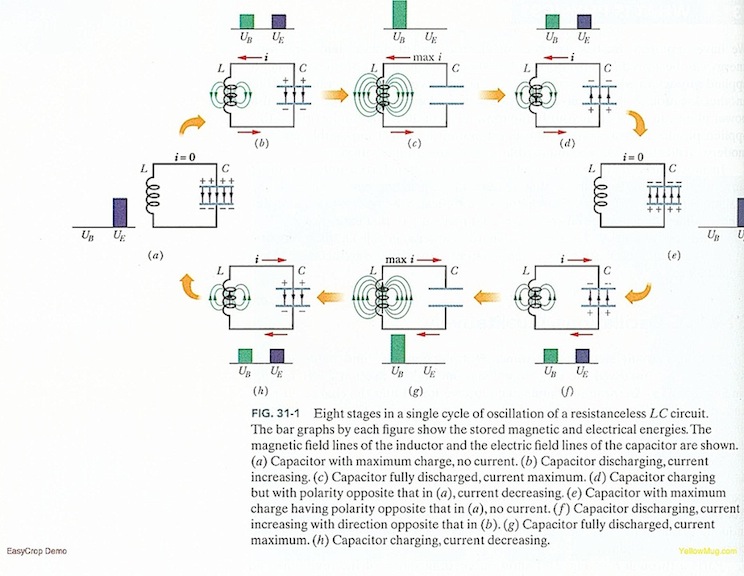The details of how an LC circuit works is best described by David Halliday in the textbook Fundamentals of Physics (scroll down for Fig. 31-1 and a quick explanation of the circuit):
“[As] the capacitor…starts to discharge through the inductor, positive charge carriers [move] counterclockwise, as shown in Fig. 31-1b. This means that a current i, given by dq/dt and pointing down in the inductor, is established. As the capacitor’s charge decreases, the energy stored in the electric field within the capacitor also decreases. This energy is transferred to the magnetic field that appears around the inductor because of the current i that is building up there. Thus, the electric field decreases and the magnetic field builds up as energy is transferred from the electric field to the magnetic field.
The capacitor eventually loses all its charge (Fig. 31-1c) and thus also loses its electric field and the energy stored in that field. The energy has then been fully transferred to the magnetic field of the inductor. The magnetic field is then at its maximum magnitude, and the current through the inductor is then at its maximum value I.
Although the charge on the capacitor is now zero, the counterclockwise current must continue because the inductor does not allow it to change suddenly to zero. The current continues to transfer positive charge from the top plate to the bottom plate through the circuit (Fig. 31-1d). Energy now flows from the inductor back to the capacitor as the electric field within the capacitor builds up again. The current gradually decreases during this energy transfer. When, eventually, the energy has been transferred completely back to the capacitor (Fig. 31-1e), the current has decreased to zero (momentarily). The situation of Fig. 31-1e is like the initial situation, except that the capacitor is now charged oppositely.
The capacitor then starts to discharge again but now with a clockwise current (Fig. 31-1f). Reasoning as before, we see that the clockwise current builds to a maximum (Fig. 31-1g) and then decreases (Fig 31-1h), until the circuit eventually returns to its initial situation (Fig 31-1a).”
Thus, this transfer of energy from the electric field of the capacitor to the magnetic field of the inductor and back again is what causes the current in the circuit to oscillate.
